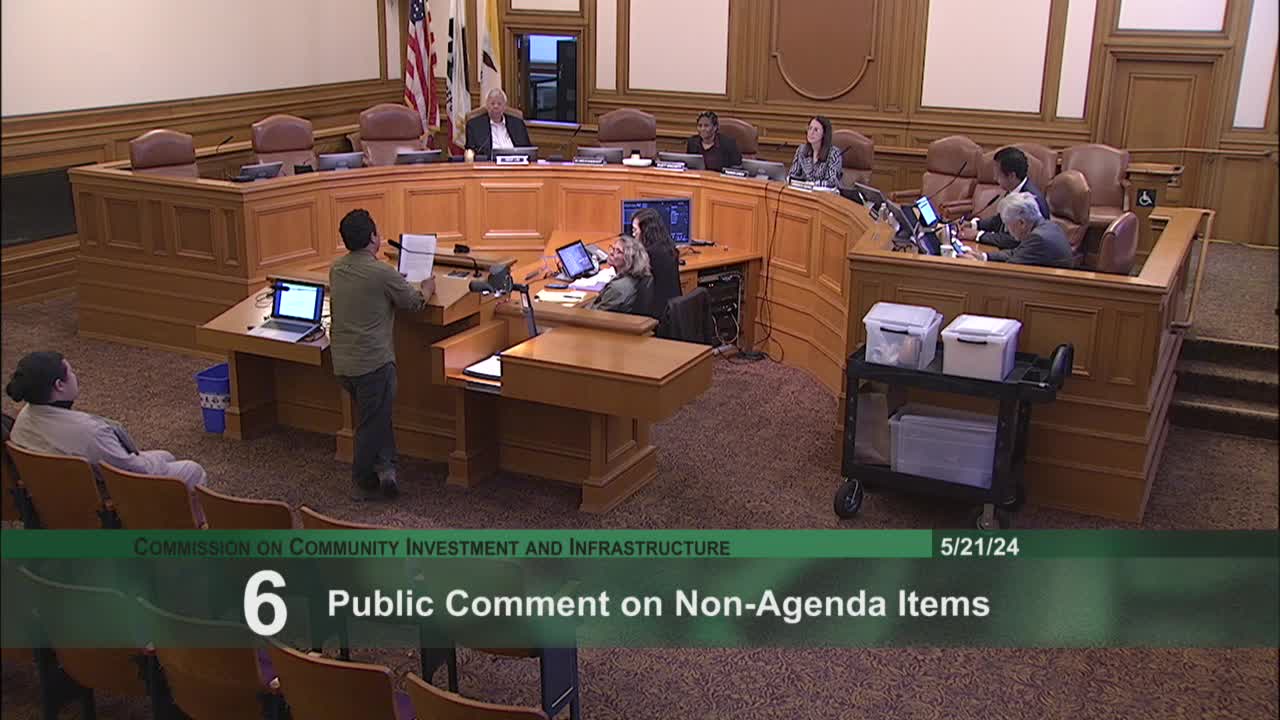Hunters Point tenants urge San Francisco commission for urgent roof repairs
May 21, 2024 | San Francisco City, San Francisco County, California

This article was created by AI summarizing key points discussed. AI makes mistakes, so for full details and context, please refer to the video of the full meeting. Please report any errors so we can fix them. Report an error »

In a recent San Francisco government meeting, concerns over the future of affordable artist spaces at the Hunters Point Naval Shipyard were brought to the forefront. Independent master tenants of Parcel B, which includes several historic buildings, voiced urgent requests for assistance in addressing critical safety issues related to the deteriorating roofs of their facilities.
Since 1984, these buildings have served as vital spaces for artists and small businesses, including Lorna Kollmeyer Artemal Plaster, the last remaining ornamental plaster company in the city. The tenants highlighted that their livelihoods depend on these spaces, which are among the last affordable options available to artists in San Francisco. They emphasized the need for immediate action to repair the roofs, which have not been adequately maintained due to constraints imposed by an outdated interim lease and a lack of resources.
During the meeting, one tenant recounted a recent walkthrough with city officials, including representatives from the Office of Community Investment and Infrastructure (OCII) and the mayor's office, to showcase the urgent condition of the buildings. The tenants expressed frustration over years of seeking help from various agencies, including the city, the U.S. Navy, and the Lennar Corporation, without any substantial progress.
Another tenant, Kollmeyer, underscored the importance of their work in preserving San Francisco's architectural heritage and the challenges faced by small, independent businesses in the area. She called for a collaborative approach to find creative solutions that would allow them to continue operating and contributing to the community.
The discussions at the meeting reflect broader concerns about the preservation of affordable spaces for artists and small businesses in San Francisco, particularly as redevelopment efforts continue in the Hunters Point area. The tenants' plea for immediate action highlights the ongoing struggle for affordable housing and workspace in a city known for its high cost of living.
As the meeting concluded, the urgency of the situation was clear, with tenants hoping for a renewed commitment from city officials to address their needs and ensure the survival of these crucial artistic spaces. The outcome of these discussions could have significant implications for the future of the arts community in San Francisco, as well as for the preservation of its cultural heritage.
Since 1984, these buildings have served as vital spaces for artists and small businesses, including Lorna Kollmeyer Artemal Plaster, the last remaining ornamental plaster company in the city. The tenants highlighted that their livelihoods depend on these spaces, which are among the last affordable options available to artists in San Francisco. They emphasized the need for immediate action to repair the roofs, which have not been adequately maintained due to constraints imposed by an outdated interim lease and a lack of resources.
During the meeting, one tenant recounted a recent walkthrough with city officials, including representatives from the Office of Community Investment and Infrastructure (OCII) and the mayor's office, to showcase the urgent condition of the buildings. The tenants expressed frustration over years of seeking help from various agencies, including the city, the U.S. Navy, and the Lennar Corporation, without any substantial progress.
Another tenant, Kollmeyer, underscored the importance of their work in preserving San Francisco's architectural heritage and the challenges faced by small, independent businesses in the area. She called for a collaborative approach to find creative solutions that would allow them to continue operating and contributing to the community.
The discussions at the meeting reflect broader concerns about the preservation of affordable spaces for artists and small businesses in San Francisco, particularly as redevelopment efforts continue in the Hunters Point area. The tenants' plea for immediate action highlights the ongoing struggle for affordable housing and workspace in a city known for its high cost of living.
As the meeting concluded, the urgency of the situation was clear, with tenants hoping for a renewed commitment from city officials to address their needs and ensure the survival of these crucial artistic spaces. The outcome of these discussions could have significant implications for the future of the arts community in San Francisco, as well as for the preservation of its cultural heritage.
View full meeting
This article is based on a recent meeting—watch the full video and explore the complete transcript for deeper insights into the discussion.
View full meeting
